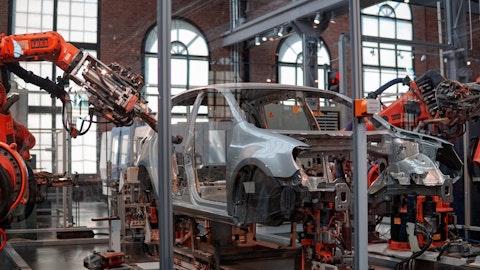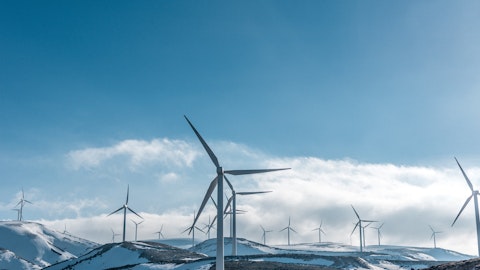Tommy Moll: Thanks, Dave. I’ll turn it back.
David Gitlin: Thanks, Tommy.
Operator: Please stand by for our next question. The next question comes from Noah Kaye with Oppenheimer. Your line is now open.
Noah Kaye: Thanks, Dave, congratulations. I’m likewise intrigued by the commentary around the battery storage and solar PV opportunity. I think you said in your prepared remarks there was an opportunity to take some of those offerings more broadly across carriers. So I know maybe it’s early days of thinking about this, but how might you actually implement that how much you architect similar offerings for the company in North America or other markets? Is this sort of a — we learned at the start here and then build that over time?
David Gitlin: Yeah, I think so. No. We have long been studying how do we connect these dots in North America. And we’ve been in discussions with solar providers. We’ve been having a series — even with our Board just last week, a series of strategy discussions around battery because — it’s not whether it’s when these systems get interconnected. When you think about an electric heat pump, you think about solar that relies on DC — solar producing DC avoiding DC to AC conversion, DC feeding batteries for storage feeding into the heat pumps. These systems are inevitably going to be connected. There are probably more channel complexities in the US than there are in Europe. But we have been working on strategies to really enter the US with a holistic offering.
What’s really unique about Viessmann is they have a very unique battery capability. So they not — they only buy the cells but they have a modular concept where they can actually customize the batteries to any size home for any demand they have. So their battery design and capabilities are a bit unique. That may be an initial easier part for the U.S. and then solar may follow. But the first order of business, expand all of their capabilities and investments throughout Europe. Second, we’ll be take it to places like the U.S. and globally and we’ll have to do that in a phased approach. But again, when we showed our $250 billion TAM at our Investor Day last year we never included Solar PV and Battery that just introduces close to another $50 billion TAM which is tremendous upside and importantly, differentiating.
Noah Kaye: Right. If we can talk about heat pump technology and development for a minute there are some differences obviously between your product portfolio and Viessmann they’ve been — as you actually mentioned they’ve been a very vocal advocate for natural refrigerants. How do we think about some of the ways in which their portfolio complements your existing one? How do we think about maybe some product development synergies overtime?
David Gitlin: I think that’s one of the most exciting things. We haven’t factored in any of the revenue synergies into the €200 million estimate that we gave. But you think about some of the things they do very well. They are very much out in front on natural refrigerants. I mentioned that in terms of their heat pump it actually uses 50% less floor space and it uses significantly less installation time which again when you have a shortage of qualified installers are across Europe that’s enormously differentiating and that can provide a lot of value to us per carrier outside of Viessmann. The — on the flip side with companies like Toshiba, we have world-class inverter technology. We’ve invested so much over the years in heat exchangers fans air handlers.
So there’s a lot of technology that we put with our 5,000 engineers today at Carrier a lot of resources into develop world-class compressor designs how we bring that into the Viessmann portfolio as well. So the technology synergies added on with the digital synergies because they have one base we have a bound a lot of the digital subscription type offerings and digital platforms will really cut across both entities seamlessly.
Noah Kaye: That’s great color. Thanks.
David Gitlin: Thank you. Thanks Noah.
Operator: The next question comes from Deane Dray with RBC. Your line is open.
Deane Dray: Thank you. Good morning everyone. I add my congratulations.
David Gitlin: Thank you, Deane.
Deane Dray: Dave, I just — I might have missed this but for Patrick, are you going to move Fire & Security and commercial refrigeration to discontinue? What would that process fee and timing?
Patrick Goris: We will do that at the right point. My expectation is that several quarters away and there are some specific requirements that need to be met for us to get there. And so if it happens at all it’s going to happen several quarters from now.
Deane Dray: Got it. And then, maybe just give us a perspective on Viessmann how they fare during the whole supply chain pressures how did they do in price cost? And any sense about their backlog and past due?
David Gitlin: Well, I would say they’re very similar to what us, and many other companies experienced. I think the good news is that they’ll be coming in with backlog because they experienced some of the same supply chain issues that we all experienced. They navigated it as well if not better than anyone. But look we all ran into some of the same constraints. They’re price/cost positive. They’ve — one of the very I think exciting — many exciting things is that they clearly can charge a premium. They have they will continue to be able to do so. So pricing is not an issue for them. And I think that one of the exciting things on the combination is I think we’ll bring a lot of value on the cost side with our supply chain. And then keep in mind that if you look at the last few years despite all the supply chain they’ve been growing 15% sales and EBIT CAGR between 2020 and 2023 and their margins have improved during this time.
And in fact Max just told me two nights ago that their margins were exceeded their expectations for March. So they continue to under-promise and over-deliver and I expect that they will continue to do so.
Deane Dray: That’s really helpful. And can you just clarify in your answer to Tommy’s question regarding the distribution model, just going directly to 75,000 installers if it works for them, that’s great. I don’t think you would try to fix something that’s not broken. But how does that strike you in terms of efficiency?
David Gitlin: Well, look it’s extremely efficient in the European market. One of the things that is in Europe is — which is a little bit different than the United States is that first you start with distributors then you have wholesalers. And the wholesalers there are typically agnostic. They will carry multiple different brands and they will provide the installer what the installer pulls for. Our distribution channel here in the United States it’s typically exclusive. So our distributors are exclusively us and our brands. So I think it’s an extremely efficient model there. Our only goal would be to expand it, expand it, invest in it, continue to grow it. And they’ve done a phenomenal job getting it from where it was 30 years ago to where it is today and we just want to invest in expanding it and continue to make it the truly differentiated channel that it is.
Deane Dray: Thank you.
David Gitlin: Thank you.





